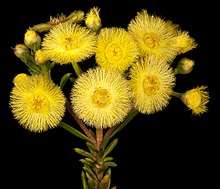Verticordia rutilastra
Verticordia rutilastra, commonly known as little grandiflora, is a flowering plant in the myrtle family Myrtaceae and is endemic to Southwest Australia, a biodiversity hotspot in Western Australia. It is a small shrub with short upper branches, narrow leaves and yellow, feathery flowers, often with a star-like red centre.
| Little grandiflora | |
|---|---|
 | |
| Scientific classification | |
| Kingdom: | Plantae |
| Clade: | Tracheophytes |
| Clade: | Angiosperms |
| Clade: | Eudicots |
| Clade: | Rosids |
| Order: | Myrtales |
| Family: | Myrtaceae |
| Genus: | Verticordia |
| Subgenus: | Verticordia subg. Chrysoma |
| Section: | Verticordia sect. Unguiculata |
| Species: | V. rutilastra |
| Binomial name | |
| Verticordia rutilastra | |
Description
Verticordia rutilastra is an irregularly branched shrub with short upper branches, which grows to a height of 20–70 cm (8–30 in) and 5–50 cm (2–20 in) wide. Its leaves are linear in shape, 4–8 mm (0.2–0.3 in) long and more or less triangular in cross-section with a rounded end with a point.[2]
The flowers are arranged in corymb-like groups on the ends of the branches, each flower on an erect stalk 10–15 mm (0.4–0.6 in) long. The floral cup is about 2 mm (0.08 in) long, rough and glabrous. The sepals are about 5 mm (0.20 in) long, spreading, yellow at first, turning red with age with 8 to 10 feathery lobes. The petals are a similar colour to the petals but change colour earlier, so that the red appears to spread from the centre of the flower. The petals are about 4 mm (0.2 in) long, spreading, with long, pointed, finger-like lobes. The style is very short and straight. Flowering time is from September to November.[2]
Taxonomy and naming
Verticordia rutilastra was first formally described by Alex George in 1991, and the description was published in Nuytsia.[1][3] George gave the specific epithet "from the Latin rutilus (red with a metallic lustre) and aster (a star), in reference to the appearance of the flower as it ages and turns red; the petals change first and together appear "star-like".[3]
George placed this species in subgenus Chrysoma, section Unguiculata, along with V. nobilis and V. grandiflora.[3]
Distribution and habitat
This verticordia grows in sand, often with loam, clay, or gravel in heath, often with other verticordia species on rocky hills. It occurs in an area between the Lesueur National Park, Alexander Morrison National Park, and Moora[2] in the Avon Wheatbelt, Geraldton Sandplains and Swan Coastal Plain biogeographic regions.[4]
Conservation
Verticordia rutilastra is classified as "Priority Three" by the Western Australian Government Department of Parks and Wildlife,[4] meaning that it is poorly known and known from only a few locations but is not under imminent threat.[5]
Use in horticulture
Verticordia rutilastra is usually propagated from cuttings and although slow to establish has been grown in deep white sand with added gravel.[2]
References
- "Verticordia rutilastra". APNI. Retrieved 20 July 2016.
- Elizabeth A. (Berndt) George; Margaret Pieroni (illustrator) (2002). Verticordia: the turner of hearts (1st ed.). Crawley, Western Australia: University of Western Australia Press. pp. 154–156. ISBN 1-876268-46-8.
- George, Alex (1991). "New taxa, combinations and typifications in Verticordia (Myrtaceae : Chamelaucieae)". Nuytsia. 7 (3): 231–394.
- "Verticordia rutilastra". FloraBase. Western Australian Government Department of Parks and Wildlife.
- "Conservation codes for Western Australian Flora and Fauna" (PDF). Government of Western Australia Department of Parks and Wildlife. Retrieved 20 July 2016.
